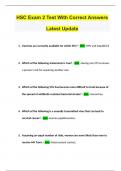Essay
Final Assignment Measurement Theory and Assessment 1 Year 1.4 Psychology
- Vak
- Instelling
This is the final assignment for Measurement Theory and Assessment 1 for year 1.4 of psychology. The final assignment for this course is a research report. This research report is written according to APA guidelines. I received an 8.8 for this report. You will find the rubrics in the back of this d...
[Meer zien]












